#summer 1904
Explore tagged Tumblr posts
Text
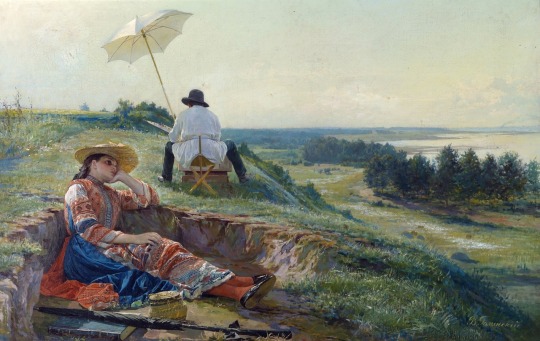
"On a hot summer’s day" (1904)
Vasiliy Golynskiy (1854-1904)
#Россия#Russia#vintage#painting#Василий Голынский#Vasiliy Golynskiy#русский художник#russian artist#artist#oil painting#русская культура#russian culture#culture#paintings#русское искусство#russian art#art#oil on canvas#russian#Eastern Europe#beauty#traditional art#aesthetic#Europe#summer#vintage art#realism#1900s#1904#20th century
355 notes
·
View notes
Text


112 notes
·
View notes
Photo

Summer Day (or Embrace On The Beach) (The Linde Frieze), 1904. Edvard Munch. Oil on canvas.
71 notes
·
View notes
Text

6 notes
·
View notes
Text


FUN FACT:
The gold medals at the 1904, 1908, and 1912 Olympic Games were all made of solid gold.
Today, gold medals aren't actual gold.
The International Olympic Committee requires that gold medals must be made of at least 92.5% silver but also have about six grams of gold. 🥇
#Olympic Games#International Olympic Committee#gold medals#1904 Olympic Games#1908 Olympic Games#1912 Olympic Games#2024 Paris Olympic Games#2024 Summer Games#Paris 2024#Paris#France#fun facts
5 notes
·
View notes
Text















The 1904 United States presidential election was the 30th quadrennial presidential election, held on Tuesday, November 8, 1904. Incumbent Republican President Theodore Roosevelt defeated the Democratic nominee, Alton B. Parker.
#Theodore Roosevelt#Teddy Roosevelt#elected#US president#South Dakota#8 November 1904#120th anniversary#US history#controversial memorial#USA#controversy#Mount Rushmore National Memorial#summer 2019#travel#vacation#original photography#tourist attraction#landmark#sculpture#Gutzon Borglum
3 notes
·
View notes
Text

𝔐𝔦𝔡𝔡𝔞𝔶 𝔬𝔫 𝔱𝔥𝔢 𝔅𝔢𝔞𝔠𝔥 𝔬𝔣 𝔙𝔞𝔩𝔢𝔫𝔠𝔦𝔞 1904
~~~~~~~~~~~~~~~~~~~~~~~~~~~~~~~~~~~~~~~~~~~~~The summer vibes that come from this painting are just scrumptious
4 notes
·
View notes
Text

gotta have some background noise while reading, after all

#one summer I got bored and read an entire Trivial Pursuit set#and I had a 1904 Funk and Wagnall encyclopedia set so it was extra fun to read
20K notes
·
View notes
Text

1 note
·
View note
Text


John Singer Sargent
Man Reading (Nicola d’Inverno), 1904-08
Collection of Reading Public Museum
The sitter of this rather loosely painted sketch of a man reading is most likely Nicola d’Inverno, the artist’s manservant who was in his service from the 1890s through 1917. The painting may have been painted at the inn at Purtud in the Italian Alps, where Sargent and his friends spent several summers between 1904 and 1908.
178 notes
·
View notes
Note
Hello! I wanted to ask about these drawings of Sophie and Nina! I recently took more notice to what kind of dresses they were wearing and wanted to know more ! The lingerie dresses Nina and Sophie are wearing seem more fancy (is that the right word? More like very detailed). I believe those type of dresses were worn during the spring and summer by various economic classes. The amount of detail and the type of fabrics seem to be used kind of makes it look more expensive. So I wanted to ask if those dresses were saved for portraits and more formal events, or did they have others like this? My knowledge of the Edwardian fashion era is very scarce, so I wanted to ask. And finding information about the type of dress Sophie was wearing in her standalone portrait was a bit hard to find lol. To sum up more of the question, were the two more in the middle or upper class when they were younger?
Another question, did these take place before Sophie and Nina came to America? I was wondering since the picture of the two took place in 1902, while we know Rocky was born in 1904; so the timeline would be pretty quick from when they went to America to Sophie and Rocky's dad have met and so on.


Sorry for these long winded questions! Thank you for your time!
Nina and Sophie immigrated with their family when they were teenagers, before the turn of the century. They were working class. Lingerie dresses were a sort of outdoor summer look of the Edwardian period. They weren't strictly relegated to the upper classes - how fancy they were fell on a spectrum. And, in fact, a lot of middle class and working class women gathered their own material and made their own dresses. The dresses in the "photo" here are more of the fancy, probably-not-homegrown sort, but they didn't belong to Nina and Sophie. They were borrowed (for the photo) from a family they both worked for as housekeepers. Something like a shirtwaist (a sort of blouse) and skirt would have been their more normal attire. Though by modern standards even a lot of relatively workaday Edwardian clothes look pretty fancy without context.
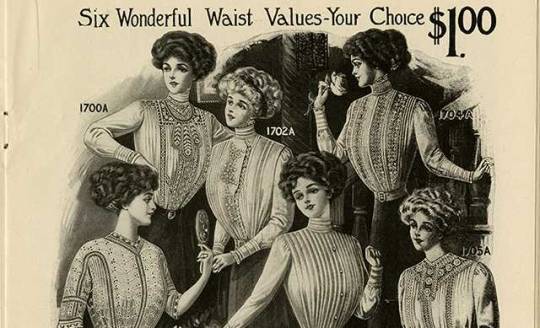
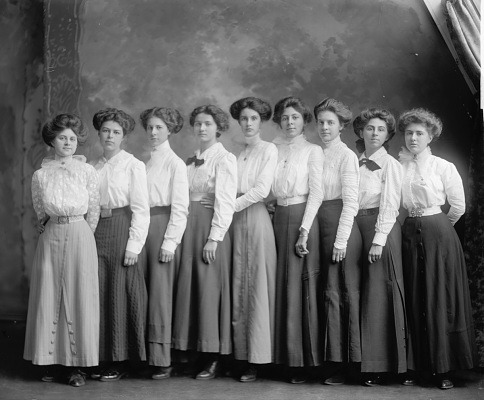
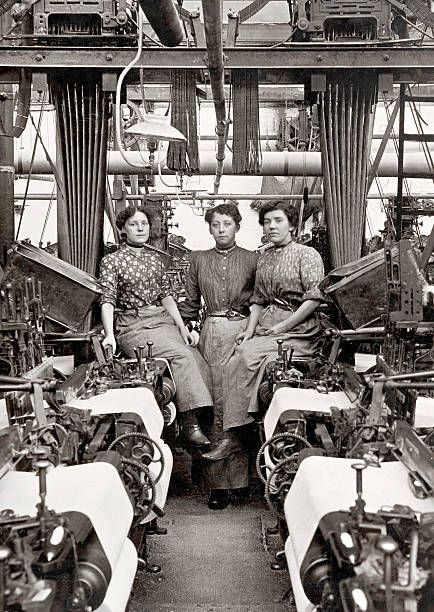
723 notes
·
View notes
Text
The lost boys main hcs
Marko
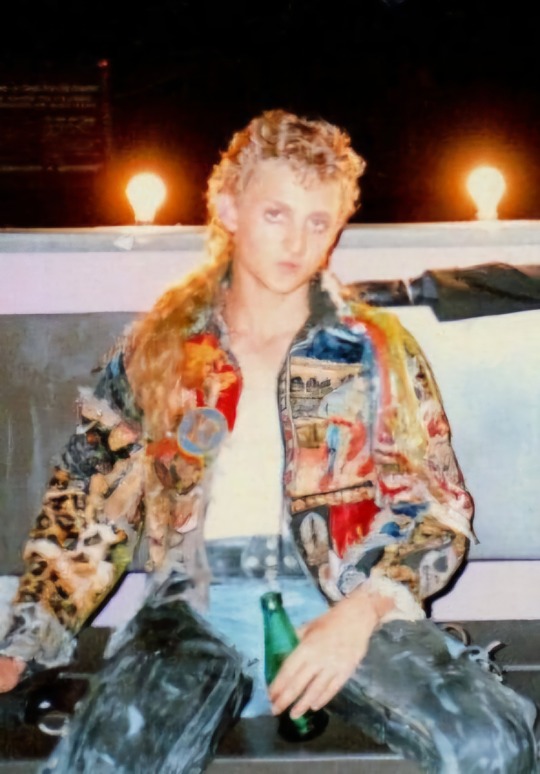
5th times the charm with trying to post this.tumblr hates me. This isn't proofread. Sorry it's short I'm tired as fuck and irritated. But I hope you enjoy it nonetheless 🖤
Marko is an only child, and he grew up without a father. His mother was a seamstress and worked out of their home when he was a child. His mother was Italian, and his father was Swedish. When Marko was born, they were already living in the united states though so Marko had never been to either country, and he had never met any of his other family members. his dad died when he was 8, so he hardly remembers him now. His mother, on the other hand, died on his 16th birthday, falling victim to the san Francisco plague in 1904. Which was an epidemic of the black plague. He had to abandon her in their home to avoid catching it himself. Taking the last of the money they had and the necklace his mother wore with a picture of their family in it. Not long after, he found the boys, and they all stuck together (as you can guess), but not until after he struggled around town by himself for a few months. God, i need to stop making this shit sad hand on switching gears. He was the youngest when the boys got turned into vamps he had only turned 18 that summer He really tries to act more mature than he is, but as soon as something funny happens, that's over. Marko has a really good sense of humor, but he finds a lot of really stupid shit funny. He's the type of dude to watch his friends fall face down ass up on concrete and start laughing and snapping a photo before asking if they are ok (he is me) This also can lean into how he does lowkey bully people on the boardwalk. Mostly surf nazis but let's be so deadass he's kind of a dick to everyone there in his own special way. Him and paul have a tendency to double team people to: like whoever they come at wont have a chance to say anything cause as soon as one of them pauses the other jumps in to just dog on the person who annoyed them. Some of his insults get pretty creative as well: so if he says something to you thats just out of pocket,like 85% of the time its one of the ones that makes you stop to think about it before you can even get offended 🤣 Strange enough, though. He is very well spoken and charismatic when you talk to him normally. When talking, you notice after a while that he's not one of those folks that cuss every other sentence. Like he will throw it in there like everyone does, but not all the time if you feel me Idk how to describe it. he still talks like a normal person and uses slang and stuff, but he is oddly classy vocabulary wise. He's got a slightly softer tone to his voice as well, which makes his way of speaking come off smoother. He's also extremely smart. Having conversations with him is never really dull or unpleasant. (Unless you're an unlucky boardwalk asshole) Marko is very imaginative and creative. He never stops coming up with things. He hoards hobbies like a dragon hoard gold. From painting to sewing to cooking to wood carving, He just knows how to do this stuff, and he loves it. You will never catch him doing nothing. Even when he's spaced out at the wall, the dude is fiddling with something or sewing. Something together, he just can't stop. He loves giving gifts to friends as well. All of the boys have gifts from Marko that he's made himself. Mostly cause he loves showing off he has skill and unlike Paul he doesn't care if people touch his stuff so he will drag you around his space handing you stuff and showing you everything he's made/ collected cause he's just so proud. Just don't break it. He will be fucking pissed if You break it. Or if you give away anything he gifted you. Also he will talk to you about this stuff for hours on end if you let him (Do let him. He will love you for life if you show Intrests in the things he likes) his space is really cluttered. But looking around, it's mostly albums,art, fabric,patches, and various random objects.
other then that he's really clean. On that note He does not like getting covered in blood when he eats just sayin. He's like the least messy eater of the group mainly cause he hates getting it on his jacket. Plus the texture of dried blood on him makes him want to rip his skin off. It's just one of those things he can't stand So he makes sure to clean up fast. That doesn't mean he doesn't like toying with victims though he's a jumpscare master. He likes to scare his victims half to death before beating the shit outta them. He jokes that hes “tenderizing The meat”. When he does this He gets a kick outta that one. Oh he also likes music, he's not like overly into it though He likes alot of different types as well. Some of his favorite generas are Rock,goth,classical, and some 30s jazz strange enough. He does not give a DAMN what the others have to say about his music taste. if He wants to play his music it will be loud and proud. If they don't like it they are free To take it up with him. (They never will)
58 notes
·
View notes
Text
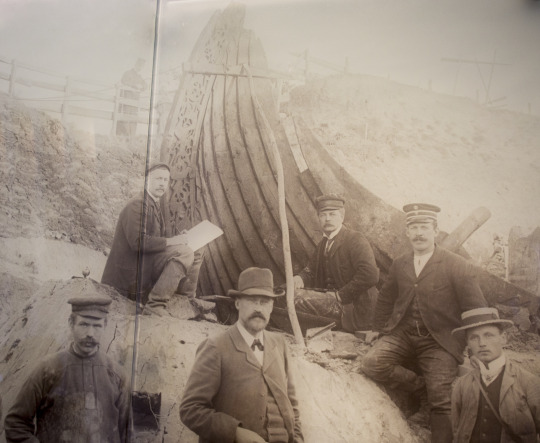
Excavation of the Oseberg Ship 1904
On 8 August 1903, the archaeologist Gabriel Gustafson received a visit from Oskar Rom, a farmer who had dug into a large burial mound on his property and had come across the remains of a ship. The special thing about this ship - it is the grave of two women from the year 834 AD.
Two days later Professor Gustafson started his investigations at the farm of Lille Oseberg at Slagen in the county of Vestfold. He found several parts of a ship, decorated with ornamentation from the Viking era.
The archaeologist was certain that the mound was a ship burial from Viking times. But to avoid problems with the autumn weather, the archaeologists waited until the following summer before starting the dig in earnest. The excavation of the Oseberg mound was of great interest to the public.
The dig had to be secured with a fence, signs and a guard to ensure that nobody interrupted the work or came too close to the objects. In his diary, Gustafson complains about being on show when heworked.
When the excavation was completed, the most time-consuming and demanding work was still to come. Although the excavation itself took less than three months, it took 21 years to prepare and restore the ship and most of the finds.
The ship was dried out very slowly before it was put together. Great emphasis was placed on using the original timber where possible. Today over 90 per cent of the reconstructed Oseberg ship consists of original timber.
#naval history#naval artifacts#oseberg ship#viking ship#early 20th century#excavation#8th century ad#medieval seafaring
79 notes
·
View notes
Text
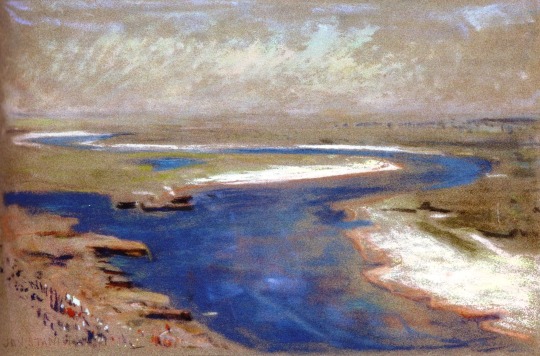

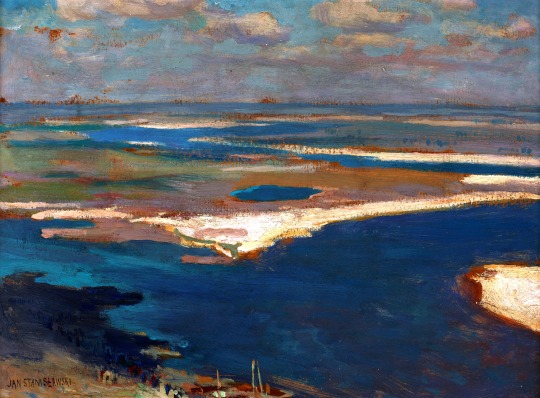
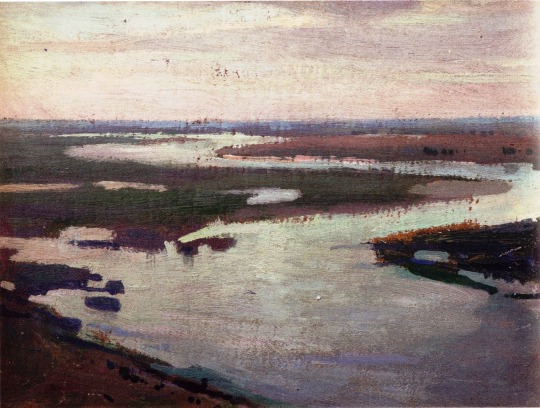
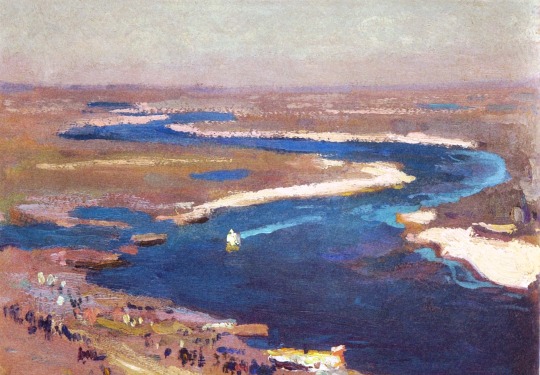
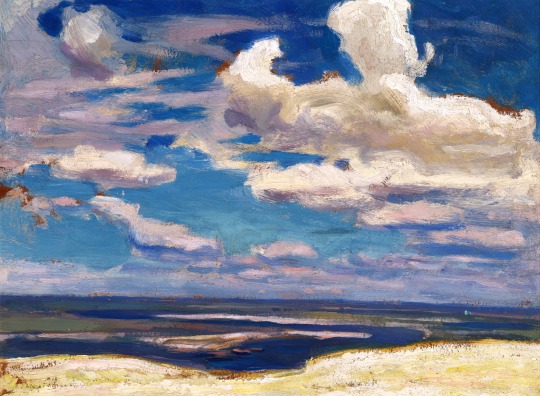
The Dnieper by Jan Stanisławski (1860-1907), the Polish artist, born near Korsuń (Корсунь) in Ukraine.
The Dnieper in Summer, pastels on cardboard, 34,4 cm X 51 cm (c. 1904). From a private collection.
The Dnieper, pastels on paper, 33,7 cm X 52 cm (c. 1903)
The Dnieper River in Blue, oils on cardboard, 23,8 cm X 32 cm (1904)
The Dnieper Limans at Dawn, oils on cardboard, 16,2 cm X 22,2 cm (1903)
The Sapphire Dnieper, oils on Bristol board, 16 cm X 24 cm (1904)
A Cloud over the Dnieper, oils on Bristol board, 24 cm X 32,3 cm (1903)
Paintings 2-5 are from an art collection of the National Museum in Kraków (Poland):
#dnieper river#ukraine#ukrainian landscape#polish art#jan stanisławski#landscape art#art#landscape painting
255 notes
·
View notes
Text

Lucy Diggs Slowe (July 4, 1885 – October 21, 1937) was an American educator and athlete, and the first Black woman to serve as Dean of Women at any American university. She was a founder of Alpha Kappa Alpha sorority, the first sorority founded by African-American women.
Slowe was a tennis champion, winning the national title of the American Tennis Association's first tournament in 1917, the first African-American woman to win a major sports title. In 1922, Slowe was appointed the first Dean of Women at Howard University. She continued in that role for 15 years until her death. In addition, Slowe created and led two professional associations to support college administrators.
Lucy Diggs Slowe was born in Berryville, Virginia to Henry Slowe and Fannie Potter Slowe. While various sources put her birth year as 1885,[3][4] others have said 1883. She was one of seven children. Her father's occupation has been reported as a hotel operator, restaurant proprietor and farmer. He died before Lucy turned one and her mother died shortly after. Following her mother's death, Lucy and her sister Charlotte were raised by her aunt Martha Price in Lexington, Virginia. At thirteen, Lucy and her family moved to Baltimore, Maryland, where she attended the Baltimore Colored High and Training School. She graduated second in her class in 1904, receiving one of the two-sponsored scholarships to Howard from the Baltimore City School Board.
Slowe was the first person from her school to attend Howard University, the top historically black college in the nation, at a time when only 1/3 of 1% of African Americans and 5% of whites of eligible age attended any college.
After graduation in 1908, Slowe returned to Baltimore to teach English in high school. During the summers, she started studying at Columbia University in New York, where she earned her Masters of Arts degree in 1915.
#black tumblr#black history#black literature#black excellence#black community#civil rights#black history is american history#black girl magic
116 notes
·
View notes
Text
THIS DAY IN GAY HISTORY
based on: The White Crane Institute's 'Gay Wisdom', Gay Birthdays, Gay For Today, Famous GLBT, glbt-Gay Encylopedia, Today in Gay History, Wikipedia, and more … February 5



1848 – Joris-Karl J.K. Huysmans (d.1907), born in Paris of a French mother and Dutch father, was an important figure in the Aesthetic and Decadent movements, who exemplified a style of homosexuality at a pivotal moment in the emergence of a gay identity.
Huysmans admired the descriptive writing of Charles Dickens, but practiced a form known in France as the prose poem. This genre, which typically emphasized sensation and an elaborate or exotic setting, was perfectly suited to his elegant style and rich vocabulary.
Huysmans was a prolific writer of novels, art criticism, essays, short stories, and prose poems. His most renowned work À rebours, (Against the Grain or Against Nature(1884), celebrated the decadent movement in European art and literature, later to be embraced by Oscar Wilde, Aubrey Beardsley, and others. In this novel, the protagonist, Duke Jean Floresas des Esseintes, embodies the aestheticism found in Wilde.
A wealthy aesthete living a life of pleasure in his country house, Des Esseintes is characterized by his addiction to exquisite sensations, exoticism, flowers, decoration, perfume, and art. Against the Grain ranks with Wilde's Picture of Dorian Gray and Moore's Confessions of a Young Man as important examples of the decadent movement.
It is now considered an important step in the formation of "gay literature". À rebours gained notoriety as an exhibit in the trials of Oscar Wilde in 1895. The prosecutor referred to it as a "sodomitical" book. The book appalled Emile Zola, who felt it had dealt a "terrible blow" to Naturalism
Huysmans maintained a correspondence with numerous writers of his day, including the homosexual symbolist poet Jean Lorrain and the novelist André Gide. Huysmans met Paul Verlaine in the summer of 1884, and in 1904, he edited and prefaced Verlaine's Religious Poetry.
Although Wilde was a more notorious figure than Huysmans, Huysmans influenced several of Wilde's artistic principles, especially those associated with "art for art's sake," "Art Nouveau," "decadence," and "impressionism."


1914 – Born: William S. Burroughs (d.1997) who, In his novels as in his life, was an outlaw and a provocateur. Beginning with Naked Lunch (1959), his fiction was distinguished by violently hallucinatory images, rendered in prose that brilliantly mimics the speech of criminals, redneck sheriffs, bureaucrats, political extremists, and hipsters. A series of later writings applied collage techniques to the novel form. Burroughs always incorporated transgressive sexual imagery and situations into his writing. In this, he went far beyond the acknowledgment, in the 1950s, of his own homosexuality.
Most of his novels contain representations of such practices as auto-erotic asphyxiation and sado-masochism. Primarily a satirist, Burroughs treated both sexuality and language as manifestations of social power — and as sites of conflict.
Born in St. Louis, Missouri, to a wealthy family, William Burroughs studied English, medicine, and anthropology at Harvard and the University of Vienna before becoming addicted to narcotics in the mid-1940s. Following an arrest for heroin and marijuana possession, he fled to Mexico. There, in 1951, he accidentally shot his wife, Joan Burroughs, during a drunken imitation of William Tell. He spent much of the 1950s recovering from heroin addiction and brooding over the act of violence that ended his companion's life.
Life in the underworld of addicts and petty criminals is the basis of his first published novel, Junkie (1953), written in a "hard-boiled" style and published under the pseudonym of "Bill Lee" (his mother's maiden name). During this period, Burroughs started another novel, in the same stylistic vein, describing the gay demimonde; this unfinished manuscript was published, much later, as Queer (1985).
With Naked Lunch (1959), Burroughs abandoned the naturalistic depiction of "outsider" subcultures and began to write in a surrealistic and bitterly satirical mode. This novel incorporated characters and scenarios Burroughs had created while improvising skits to amuse his friends (including Allen Ginsberg and Jack Kerouac, fellow members of the Beat Generation literary group). Often highly scatological, laced with the argot of various underworlds Burroughs had encountered in his travels, the paranoiac and hallucinatory scenes in Naked Lunch treated addiction as a complex metaphor for all varieties of domination and control. The novel was subject to a number of court cases for obscenity.
During the 1980s, Burroughs began performing with some regularity in films and on television, and several recordings have been made of the writer reading portions of his work. David Cronenberg's film adaptation of Naked Lunch (1992) treated the novel as a story of the author's literary and sexual self-discovery. Burroughs's work has been influential for several generations of novelists, poets, performance artists, and feminist and queer theorists.


1942 – Gil Wechsler was the first resident lighting designer at the New York Metropolitan Opera. He lit his inaugural show in 1977 and, over the next 20 years, made days dawn, rain fall and cities burn in 112 Met productions, 74 of them new.
His career also took him to London, Paris and other international centers of opera and ballet. Wherever he was designing, he knew that audiences often didn’t take much notice of his contributions to a production — which was usually the point. “If lighting is good, you really shouldn’t notice it often,” he told Opera News in 1987. “In some operas, however, such as ‘Die Walküre,’ the lighting becomes the show. It should seem natural — it shouldn’t jar, but you should be moved by it.”
He graduated from Midwood High School in Brooklyn and studied for three years at Rensselaer Polytechnic Institute in Troy, N.Y., before realizing that a career in business or finance was not in his future. In 1964 he earned a theater degree at New York University, and in 1967 he received a master of fine arts degree at Yale.
Upon graduating he found work as an assistant to the prominent set and lighting designer Jo Mielziner, and in 1968 he received his first Broadway credit, as lighting designer on the Charles Dyer play Staircase. He would have one more Broadway credit, in 1972, for Georges Feydeau’s There’s One in Every Marriage. Before coming to the Met, he also designed for the Stratford Festival in Ontario, the Harkness Ballet, Lyric Opera of Chicago, the Guthrie Theater in Minneapolis and other leading regional theaters and festivals.
At the Met, Mr. Wechsler worked with Otto Schenk, Jean-Pierre Ponnelle, David Hockney and many other leading directors and designers. Lighting for the Met is particularly challenging because — unlike on Broadway, for instance — the shows change on a weekly or even daily basis. One of Mr. Wechsler’s accomplishments was to develop accurate records of the lighting schemes for each production, so that one show could be swapped for another more efficiently.
Wechsler died on 2021 at a memory-care facility in Warrington, Pa. He was 79. His husband, the artist Douglas Sardo, said the cause was complications of dementia.


1960 – Born: Versatile African-American artist Nayland Blake who creates—in a variety of media—work that reflects his preoccupation with his racial and sexual identities. Interracial desire, same-sex love, racial and sexual bigotry, and the body are all recurrent themes of his increasingly influential art.
Born to an African-American father and an Irish-American mother at a time when such unions were outlawed in many parts of the United States, Blake is a black man by the definition of historical jurisprudence, yet easily passes for white. He grew up on Manhattan's Upper West Side. As a gay man, his sexual identity is similarly subject to either concealment or revelation. A self-described teenage "art nerd," Blake spent his high school years with like-minded friends hanging out in Soho and East Village galleries and lofts, watching experimental film and performances by artists such as Richard Foreman and Jack Smith.
Blake's work first came to national and international attention when it was featured in the 1991 Whitney Biennial and the 1993 Venice Biennial.
In 1995, Blake co-curated a show at the University of California, Berkeley Art Museum entitled In a Different Light: Visual Culture, Sexual Identity, Queer Practice. This was the first major show to exhibit the work of queer artists exclusively. The volume produced from the show has become a standard in queer art scholarship.
Blake's work perennially theatricalizes, and even eroticizes, the characteristically suppressed linkages between interracial desire, same-sex desire, and the overt displays of bigotry and intolerance that customarily greet such transgressions as these.
Among his most famous pieces are a log cabin made of gingerbread squares fitted to a steel frame entitled Feeder 2 (1998). When it went on display, visitors furtively nibbled off bits and pieces of the cabin's interior walls, while the smell of the gingerbread filled the gallery. Another well-known work is Starting Over (2000), a video of the artist dancing with taps on his shoes in a bunny suit made to weigh the same as his lover, Philip Horvitz. The suit was so heavy that Blake could hardly move as he took choreographic directions from Horvitz offstage.
Gorge (1998) is a video of the artist sitting shirtless being hand fed an enormous amount of food for an hour by a shirtless black man from behind. In 2009, a live version of Gorge was staged in which audience members fed Blake.

Hung Bunny
Through Blake's work bounds the recurrent figure of the bunny rabbit, a seemingly innocuous character often given an ominous cast. They variously suggest a youthful naiveté, a sexual precocity, the stereotype of homosexual promiscuity, or a social slipperiness. The last meaning is perhaps best exemplified by Brer Rabbit, the "trickster" of Joel Chandler Harris's "Uncle Remus" tales.
Through his work as an artist, teacher, and curator, Blake exerts an important influence on queer art, art scholarship, and artists.


1993 – Curdin Orlik is a Swiss professional wrestler who competes in Schwingen (a type of folk wrestling native to Switzerland), and an agronomist. Orlik came out as gay in March 2020, making him the first athlete in the sport of Schwingen to come out as gay, and also the first openly gay male active in Swiss professional sports.
Orlik was raised in Landquart, Grisons. He is the brother of wrestler Armon Orlik.
Orlik competes in Schwingen, a form of folk wrestling that is native to Switzerland. Orlin was named "Schwinger of the Week" by the Swiss magazine Schlussgang in May 2019. So far in his wrestling career he has been awarded thirty-five wreaths and has won five festivals. In 2019 he ranked twenty-fourth in the Eidgenössischer Schwingerverband.
He also works as an agronomist.
Orlik was previously married to a woman, with whom he has a son. They later separated. He is the first athlete in the sport of Schwingen to come out as gay, and also the first openly gay male active in Swiss professional sports. Orlik came out in March 2020.
"For far too long I have pushed out who I really am," he said in his coming out interview with The Magazine. "I always knew that I was gay, for sure since I was 12. But I thought: this is wrong, it cannot be.
"I heard things on the school building square [like] 'you gay pig,' 'you faggot.' Or in soccer, 'such a gay pass!' Even when [wrestling]. Sure nobody really meant that, but if you're like that yourself, you think, 'Shit, that's not a good thing.'
Orlik tried to hide the truth, even from himself, even going so far as to get married to a woman. They have a two year old child, but divorced after Orlik realized he couldn't keep up the charade any longer.
"I thought: I don't want to be gay. But it's me. Now it's out."


2009 – Ryan Cran, one of the killers in the Aaron Webster gay-bashing murder in Stanley Park, Vancouver, in 2001, is released on parole after serving four years of a six-year sentence for manslaughter.


29 notes
·
View notes